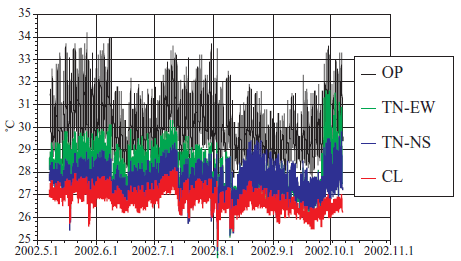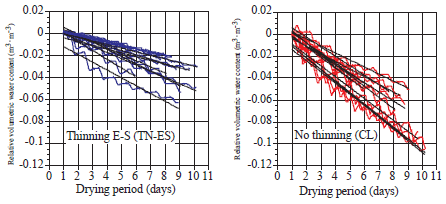Changes in soil conditions caused by thinning: an agroforestry experiment
Description
Plantation forests that consist of non-native, fast-growing species such as Acacia and Eucalyptus are increasingly prevalent in tropical regions. Some monoculture plantations are not exploitable for timber products due to their low market value, and also show very low biodiversity. A new intercropping system, in which domestic timber trees and selected cash crops such as medicinal plants are grown together, will enable the rehabilitation of tropical rainforest with higher biodiversity, while promoting the quality of life of local communities.
In an agroforestry project conducted in Sabah State, Malaysia, we are attempting to develop new techniques for promoting nurseries for timber, such as Dipterocarpacea, and cash plants, such as fruits and local medicinal plants, inside plantation forests or secondary forests. As an initial step in developing this technique, thinning was conducted to improve the light conditions on the forest floor. In this sub-topic, we evaluated how the thinning treatment affected the soil and whether thinning is effective for the planned agroforestry system.
A 1.6 ha Acacia mangium plantation stand was selected as the agroforestry trial plot. We conducted one or two line-thinning treatments from east to west (TN-EW) and from north to south (TN-NS) in some areas, with the other areas remaining as the control (CL). Three soil temperature sensors and twelve soil moisture sensors (Delta-T; ADR Theta Probe) were installed in the plots. A soil temperature sensor was also installed in the nearest open area (OP).
The average soil temperatures at 10 cm depth in the CL, TN-EW, TN-NS, and OP sites were 26.8, 27.5, 27.8, and 30.1°C, respectively. Diurnal fluctuation at the OP site was higher than the others, peaking at 34°C (Fig. 1). On the other hand, diurnal fluctuation at the CL site was the lowest, reaching a maximum of 28°C. At the TN-EW and TNNS sites, the shade effect by upper trees remained, giving a more suitable environment for nurseries than at the OP site.
Soil moisture increased very soon after rainfall, then decreased rapidly and continued to dry. The linear regression slope between drying period and soil moisture revealed a significant difference between the thinned and not-thinned plots. On the same plots, the regression slope was significantly lower at the thinned sites (TN-EW and TN-NS) than at the CL site (Fig. 2), showing that soil drying after rain was slowed by the thinning treatment. We assume this to be mainly due to the decreased rate of evapotranspiration resulting from the thinning treatment. Thinning appears to provide improved conditions for nurseries with respect to soil water content.
These results suggest that after thinning, temperature conditions 10 cm below the soil surface remain more stable and soil moisture is improved due to reduced water consumption by adult trees. We conclude that the thinning treatment is a good procedure for establishing agroforestry sites. Large areas of non-native plantation forest, originally planted to cover bare ground after forest felling, remain in an unmaintained state. Our results are of potential use as fundamental data for policymakers when drawing up new forest management strategies.
Figure, table
-
Fig. 1. Soil temperature at 10cm depth after thinning treatment. -
Fig. 2. Soil water decrease one day after rainfall. Relative volumetric water content refers to soil water content at one day after rainfall minus soil water content during drying period.
Averages of slopes were -4.65 x 10-3 and -9.29 x 10-3 at TN-ES and CL, respectively. (p < 0.01)
- Affiliation
-
Japan International Research Center for Agricultural Sciences Forestry Division
- Classification
-
Technical A
- Term of research
-
FY2004(FY2000~2006)
- Responsible researcher
-
INAGAKI Masahiro ( Forestry and Forest Products Research Institute )
TITIN Jupiri ( Forest Research Centre, Sabah )
INAGAKI Yoshiyuki ( Forestry and Forest Products Research Institute )
OHTA Seiichi ( Kyoto University )
- ほか
- Publication, etc.
-
Inagaki, M., T., Jupiri (2004):Carbon content in humid tropical plantation forest soil in Sabah. ‘Lignocellulose: Materials for the future from the tropics’ The 3rd USM-JIRCAS Joint International Symposium, Program, p.36.
KAMO, K., INAGAKI, M., JAMALUNG, L. and TITIN, J. (2004) Proceedings of the 14th annual meeting of the Japan Society of Tropical Ecology
INAGAKI, Y., INAGAKI, M. and TITIN, J. (2004) Proceedings of the 14th annual meeting of the Japan Society of Tropical Ecology
Inagaki, M., Kamo, K. and T. Jupiri (2004):Water stress in an Acacia mangium stand in Sabah, Malaysia, ‘Forest and Water in Warm, Humid Asia’, Proceedings of a IUFRO Forest Hydrology Workshop, p.99-102.
- Japanese PDF
-
2004_16_A3_ja.pdf923.15 KB


